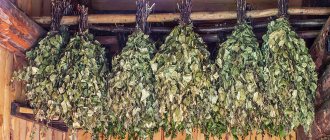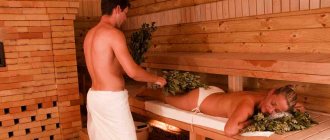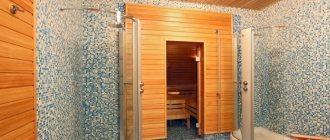It is necessary to steam a fir broom before going to the steam room; any bathhouse attendant knows this. Otherwise, they can simply injure the skin, because all coniferous brooms are distinguished by excellent rigidity and strict disposition.
The traditional use of a prickly broom in a steam room causes fear, mistrust and complete denial of the bathing procedure with a fir broom among newcomers to the bath business.
But true connoisseurs of bathing wisdom are not at all afraid of the prickly broom. And all because they know how to properly steam their fir brother.
It is worth adding to this the fact that fir branches are most suitable for use in a steam room, because these needles are softer than those of their prickly relatives. And if you steam it correctly, the fir will spare even the most sensitive skin! So it turns out that the fir broom is the most delicate among all conifers.
The formation of fir branches into a broom is simply wonderful. The result is such a wide, flat coniferous paw that perfectly pumps hot air into the steam room.

Bathhouse attendants usually steam with a fir broom in late autumn and winter. I was always surprised by this fact, but the explanation is quite simple...
The aromas of fir are very useful in the midst of colds. They have a very positive effect on the bronchi and lungs. Fresh, freshly cut fir branches in the steam room create a stunning aroma. The healing essential oil of fir has a calming effect, copes well with any nervous tension, and helps cope with stress and depression.
What beneficial properties does a fir bath broom have?
You will learn further how to steam this product. In the meantime, we propose to better understand its unique healing effect. Fir needles are not as prickly as spruce or pine needles. Therefore, it is often used to make bath brooms.

In addition, products made from the branches of this plant are considered an excellent aid in the prevention of colds. A wide and comfortable fir broom helps fight bronchitis and has a beneficial effect on the circulatory system and the entire body as a whole. A massage done with it relaxes the muscles well. And the aroma of this plant perfectly eliminates nervous tension and disinfects the air in the room.
Fir needles contain a large amount of resinous substances. They promote increased sweating and improved blood circulation in muscles and internal organs. Thanks to its disinfecting properties, this broom has a beneficial effect on the skin, cleansing it of pathogens.
Fir broom for a bath! Medicine for health
A variety of brooms for the Russian bath. “What Russian doesn’t like fast driving and a good bath with a broom?” this question asked in one of the popular feature films has already become a saying that characterizes a Russian person accordingly. Indeed, baths in our country (and not only in ours) are not only a place of relaxation, but also a special “temple” for cleansing the soul and body from all kinds of illnesses and bad thoughts, and these same thoughts and ailments are driven out with brooms.
Types of brooms for baths

There are a great variety of brooms with which people go to the bathhouse: Birch; Ericaceae; Fir; Oak; Eucalyptus; Linden; Bamboo; Brooms made from herbs (nettle, tansy, wormwood, mint, etc.).
Features of a fir broom for a bath.
But one of the most popular and in demand is the fir broom. Fir is a coniferous tree that grows in most of our country (mainly in the central part of Russia and Siberia). It is very rich in resins and phytoncides.
Phytoncides are volatile substances that, spreading (dispersing) in the air, have a high ability to kill microbes.
Fir is often confused with spruce. To distinguish these trees, you need to remember that the needles of fir are softer and longer, unlike spruce needles. In addition, they
are located to one plane, and spruce ones are located along the entire spine of the branch. If you have any doubts about determining the type of conifer, you just need to rub the needles in your hand. Fir trees will immediately give off a fragrant, resinous scent, only fir has a bright aroma that will remain on the fingers for a long time (the smell that will be captured is phytoncides). From spruce trees there will be a modest, barely noticeable aroma.
The benefits of a fir broom.
The benefits of using a fir broom in a bathhouse are so great that it will not be possible to describe all its delights in one article, therefore, it is worth focusing on the main advantages. First of all, it is the aroma. In addition to the fact that it is simply pleasant, it also kills microbes of various pathogens of acute respiratory infections and treats colds in the first stages. It copes well with a runny nose, but for this, in addition to the aroma, you also need to steam well and
bask.

Frequent use of this broom in the bath helps to lose weight. This has been proven by scientists and nutritionists for a long time. Resinous secretions
The substances promote sweating, and the aroma of fir affects the internal organs, accelerating the metabolic process.
Using a fir broom helps accelerate blood circulation in blood vessels and muscles. Fir has a high antiseptic effect. Such brooms differ from others in the presence of a high content of essential oils, which penetrate deep into the skin, eliminating diseases, improving the structure of the skin, strengthening blood vessels and thereby rejuvenating the body. The release of phytoncides and essential oils has a beneficial effect on the respiratory system and is indicated for use in cases of runny nose, sinusitis, cough, and bronchitis.

Also, using
The use of fir broom is recommended by aromatherapy specialists for general improvement of mood, stress relief, nervous exhaustion and muscle tension.
The inhaled aromas of fir will allow you to: Relax; Eliminate feelings of imbalance and anxiety; Helps you calm down. Recently, experts have discovered another property of the fir broom. Its use tones all organs and has an stimulating effect.
How to steam a fir broom correctly.
Before using this broom directly, bath attendants place it in boiling water for 15 minutes. Sometimes the broom is placed in lukewarm water for several hours. This makes the needles even softer, and the water in which the broom is infused is recommended to be used for rinsing hair after washing or the entire body.

Tingling needles act as a massage, improving blood circulation. Therefore, sometimes, the broom is not steamed, so as not to deprive the branches of the ability to “tingle slightly,” but are simply held over the steam for a couple of minutes.
It is not recommended to use a fir broom if you are individually intolerant to essential oils of coniferous trees, and also limit the use of a broom in a bathhouse if there are wounds and abrasions on the skin. There are no other contraindications for pregnant women or children. Using this type of broom in a bathhouse will prolong not only youth, but also health, improve mood and relieve stress. Stock up on fir brooms or buy them immediately before use.
Features of the workpiece
Fir grows in moist, fertile soils, in areas with a relatively cool climate and clean air. Our distant ancestors valued it for its unique healing properties and used it to make bath brooms. These products cannot be stored for a long time. For those who are interested in how and when to prepare fir brooms for a bathhouse, it will be useful to know that the needles of this plant do not tolerate the drying process well. It crumbles quite quickly, so they don’t stock it for future use.

The best time to collect fir is spring and summer. It is during these months that a large number of tender young shoots appear on evergreen trees. These fragrant branches contain many useful substances.
What is the best way to preserve fir brooms so that they do not fall off?
To preserve brooms, they usually do this: take a pair of brooms, tie them and hang them in the attic or in the barn. The main storage condition is to protect the brooms from direct sunlight and dampness. The sun's rays dry out the branches, as a result of which the broom loses all its beneficial and aromatic properties; the leaves or needles become an unattractive yellow-dirty color. Due to drying in the sun, fir brooms begin to crumble, so they should be stored exclusively in a dark, dry, cool place. Dampness is also contraindicated for coniferous brooms, since when the moisture evaporates, the needles begin to darken, wrinkle and crumble. In this regard, fir brooms should be harvested only in dry, sunny weather after the dew has disappeared.Some do this: they cut the required number of branches for the future broom and do not tie them together right away, but build a kind of sheaf from them. Then the sheaf is wrapped in a large amount of dried grass, hay, straw and also stored in the attic or in a well-ventilated shed. Immediately before going to the bathhouse, take out the twigs and tie them into a broom. This storage method allows you to preserve the branches from overdrying and excess moisture.
Another effective way to preserve fir brooms is this: in the attic or in another dark place you need to spread dried grass, creating some kind of sheet. Fir brooms are laid on this “sheet” so that they do not touch each other. You need to pour a thin layer of straw on top of the brooms. For a month, once every 2-3 days, the brooms must be turned over to the other side. After a month, the brooms should be covered with a “blanket” of fresh grass with a layer of about ten centimeters and should not be touched again. Such brooms can be stored until autumn. When the need arises, take out the branches from under the grass cover and build a broom.
These methods of preserving fir brooms are suitable for villagers and summer residents who have dry, dark rooms and sheds. How can a city dweller keep a broom? Here, too, everything is simple: you need to take several layers of newspaper or other paper, place a broom on it and wrap it tightly. It is advisable to avoid protruding ends of the broom, as air will get into the holes and the broom will begin to crumble over time. There is no need to think that the broom in the paper will become damp, begin to become moldy, or acquire an unpleasant, musty smell - the paper allows air to pass through very well, so the broom will have something to “breathe”! You can store such packages on the balcony or mezzanine.
Manufacturing process
A fir broom is made from pine needles collected in sunny, dry weather. Branches whose length does not exceed seventy centimeters are suitable for these purposes. The thickest of them are placed inside the future product, surrounded by thinner twigs. It is important to ensure that the curved edges of the shoots are facing the broom. There should be no knots or small needles in the place where the handle is supposed to be placed.

During the knitting process, the branches must be placed so that you end up with a flat broom. At the end, the assembled bundle should be tied with twine or any other strong rope. This should be done in the place where the broom handle is located. Then all that remains is to trim the ends of the fir branches and wrap the handle with a bandage or cloth.

Those who do not have the opportunity to make a full-fledged fir broom can be recommended to use oil obtained from the needles of this plant. It is extracted from spruce branches using a special apparatus. At the same time, from a two-hundred-liter barrel tightly packed with fir branches, you can get only one and a half liters of oil.
Who shouldn't steam with a fir broom?
Despite the invaluable benefits of this procedure, it has a number of contraindications. Fir bath brooms are not recommended for use by people with individual intolerance to the components they contain. These products should not be used during pregnancy. This is explained by the fact that fir does not have a very favorable effect on the unborn baby. It is also better to avoid them while treating open wounds, since a broom can cause increased pain.
The process of steaming a fir broom for a bath?
It is easy to get the maximum effect from visiting the steam room by following the tips on how to properly steam a fir bath broom.
You can prepare a broom in 1 of 3 ways:
- 4-5 hours before visiting the bathhouse, place the broom in warm water. This method allows you to soak the needles and preserve the healing properties of fir;
- if there is little time before visiting the steam room, there is a way to steam a bath broom in boiling water, letting it brew for 15 minutes;
- The broom is washed and placed in boiled water for 5 minutes. Then dried on hot coals.
The water used for steaming or soaking a fir bath broom is poured onto the stones after use. This is one of the inhalation methods that can help get rid of a runny nose and restore the airways.
How to steam a fir broom?
There are several ways to prepare. The first of them involves keeping the product in boiling water for ten minutes. This is a fairly fast method. However, the speed of preparation significantly reduces its beneficial properties. During this time, the needles are literally boiled in water, leaving the lion's share of valuable substances in it.

The second method allows you to preserve the maximum beneficial properties, but this procedure requires much more time. The fir broom must be soaked in a container of water in advance. After a few hours, its needles will become softer.
The third method involves steaming a broom with boiling water and then drying it over hot stones. At the same time, it is important to observe moderation. Otherwise, there is a risk of drying out the product.
Methods for steaming a fir broom
Fir branches are never prepared for future use for use in the bathing kingdom. Fir, like all conifers, is completely unsuitable for storage. Fir needles fall off very quickly. It is for this simple reason that you will not find coniferous brooms in retail sales. You can buy them either at the market or cut them yourself from the nearest tree.

According to the unwritten laws of nature, the best time to use fir branches is spring and summer. When nature wakes up from winter hibernation, fresh fir branches begin to grow. They are tender and completely soft; it is at this time that fir is most rich in useful, healing substances.
The first method of steaming a fir broom
The simplest and most reliable method is to immerse thorny branches in a bowl of boiling water for 30 minutes. This can be done in advance, before going to the bathhouse. But, this method is more suitable for those who have their own bathhouse, but for visitors to the state-owned kingdom, the steaming time can be reduced to 15 minutes.
With such a long stay in hot water, the needles will, of course, become soft and tender, but they will also generously give up their healing properties to the water. Therefore, if you use this method of steaming a broom, do not throw out the water afterwards. This is medicinal water, you can put it on the heater, make a foot bath and just rinse.
The second method of steaming a fir broom
This method is only suitable for owners of their own bath kingdom. In this case, the broom is soaked in long before going to the steam room - about three hours before the steam room. And the water should not be too hot - so that the “hand can tolerate it.” Then, just before use, the broom is “heated” over a hot heater.
With this method of steaming, all the beneficial and healing properties of fir are preserved.
Massage with a fir broom
The long-standing tradition of steaming with pine branches originated several centuries ago. For the first time, residents of Altai and Siberia began to do this. It is in those parts that coniferous trees are especially valued. Young, well-steamed needles do not prick at all. A massage using an aromatic fir broom has an anti-inflammatory, analgesic and disinfectant effect.
It has been established that regular use of this procedure helps strengthen the immune system, rejuvenate the skin and eliminate fatigue. In addition, such actions stimulate brain activity, relax and relieve stress. Massage with a fir broom is recommended for people diagnosed with arthritis, myalgia, neuralgia and skin diseases.











